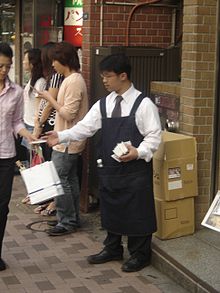Tissue-pack marketing
This article needs additional citations for verification. (October 2013) |

Tissue-pack marketing (ティッシュ配り) is a type of guerrilla marketing that is a phenomenon in Japan. Companies use small, portable tissue packages to move advertising copy directly into consumers' hands. About 4 billion of these packages of tissues are distributed on the streets annually in Japan—largely outside of subway stations. This industry generates sales in the range of ¥75 billion annually.[1]
History
The concept of tissue-pack marketing was first developed in Japan. Its origins date back to the late 1960s when Hiroshi Mori, the founder of a paper-goods manufacturer in Kōchi Prefecture called Meisei Industrial Co., was looking for ways to expand demand for paper products.[citation needed] At the time, the most common marketing freebie in Japan was boxes of matches. These were often given away at banks and then used by women in the kitchen. Mori figured tissues would have even wider appeal than the matches, and as a result he developed the machinery to fold and package tissues into easy-to-carry, pocket-size packs. The new product was marketed only as a form of advertising and was not sold to consumers.[citation needed]
Benefits

Where the more traditional flyers are often discarded without being read or simply not accepted by the consumer, the same is not true of advertising tissue-packs. The most important reason for this is because the tissues add functionality to the advertisement. This functionality has several benefits:
- Gets the ad into consumers' hands
- In an Internet survey of over 100,000 Japanese consumers conducted by Marsh Research, 76% said they accept free tissues.[1] This is a much higher rate than either fliers or leaflets.
- Gets consumers to read/look at the advert after they have accepted it
- In the same study referenced above, of those that accepted the tissue-pack, slightly more than half of the participants said they either "definitely look" or "at least glance at" the advertisement.[1] One possible reason for this increased statistic when compared to fliers is that consumers were hoping to find coupons or special offers packaged inside with the tissues.
- Helps consumers to retain the ad and its message
- The advertisement on the package is more likely to be retained by the consumer because they are being consistently exposed to it.
Global spread
Japan is still the main market for tissue-pack advertising, but the practice has begun to spread overseas.
Pocket tissue advertising was introduced in Montreal, Canada, in December 2000 by Promotion Par Main.[2] In April 2005, this marketing method was also used in Ontario, Canada, by Hold'em Promotions Inc., after the company's founders saw tissue advertising during a trip to China.[3]
In the United States, a subsidiary of the Japanese trading company Itochu, AdPack USA, introduced tissue-pack marketing in New York in 2005, and now offers it throughout the country.[1]
In 2012, the tissue marketing company Adtishoo launched operations in the United Kingdom.[4]
See also
References
- ^ a b c d Gordenker, Alice (2007-08-21). "Pocket Tissues". The Japan Times Online. Retrieved 2008-03-07.
- ^ Berube, Isabelle (2000-12-13). "Promotion Par Main lance ses pub-mouchoirs". Editions Infopresse (in French).
- ^ Perry, Dan (2005-10-20). "A Pack of Success". The UWO Gazette.
- ^ "Adtishoo aims to take off in UK". Manchester Evening News. 2012-06-11.
